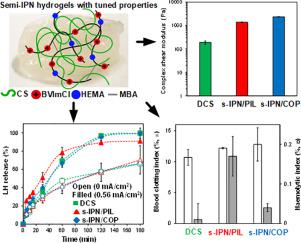Biomaterials Advances ( IF 7.9 ) Pub Date : 2020-12-16 , DOI: 10.1016/j.msec.2020.111798 Akel F. Kanaan , Ana P. Piedade , Hermínio C. de Sousa , Ana M.A. Dias

|
In this work, electro-responsive chitosan/ionic liquid-based hydrogels were synthetized for the first time, envisaging the development of iontophoretic biomaterials for the controlled release/permeation of charged biomolecules. The main goal was to enhance and tune the physicochemical, mechanical, electro-responsive, and haemostatic properties of chitosan-based biomaterials to obtain multi-stimuli responsive (responsive to electrical current, ionic strength, and pH) and mechanically stable hydrogels. To accomplish this objective, polycationic semi-interpenetrating copolymer networks (semi-IPN) were prepared by combining chitosan (CS) and ionic liquid-based polymers and copolymers, namely poly(1-butyl-3-vinylimidazolium chloride) (poly(BVImCl)) and poly(2-hydroxymethyl methacrylate-co-1-butyl-3-vinylimidazolium chloride) (poly(HEMA-co-BVImCl)). Results show that prepared semi-IPNs presented high mechanical stability and were positively charged over a broad pH range, including basic pH. Semi-IPNs also presented faster permeation and release rates of lidocaine hydrochloride (LH), under external electrical stimulus (0.56 mA/cm2) in aqueous media at 32 °C. The kinetic release constants and the LH diffusion coefficients measured under electrical stimulus were ~1.5 and > 2.7 times higher for those measured for passive release. Finally, both semi-IPNs were non-haemolytic (haemolytic index ≤0.2%) and showed strong haemostatic activity (blood clotting index of ~12 ± 1%). Altogether, these results show that the prepared polycationic semi-IPN hydrogels presented advantageous mechanical, responsive and biological properties that enable them to be potentially employed for the design of new, safer, and advanced stimuli-responsive biomaterials for several biomedical applications such as haemostatic and wound healing dressings and iontophoretic patches.
中文翻译:

半互穿壳聚糖/离子液体聚合物网络作为电响应生物材料,可用于潜在的伤口敷料和离子电渗疗法应用
在这项工作中,首次合成了电响应性壳聚糖/离子液体基水凝胶,并计划开发用于带电生物分子的受控释放/渗透的离子电渗疗法生物材料。主要目标是增强和调整基于壳聚糖的生物材料的物理化学,机械,电响应和止血特性,以获得响应多种刺激(响应电流,离子强度和pH值)和机械稳定的水凝胶。为了实现这个目标,聚阳离子半互穿共聚合物网络(半IPN)的通过结合脱乙酰壳多糖(CS)和离子液体基聚合物和共聚物,即聚(1-丁基-3-乙烯基咪唑鎓氯化物)(聚制备(BVImCl ))和聚(甲基丙烯酸2-羟甲基酯-co-1-丁基-3-乙烯基咪唑鎓氯化物)(聚(HEMA- co- BVImCl))。结果表明,制备的半IPN具有较高的机械稳定性,并在包括碱性pH在内的宽pH范围内带正电。在外部电刺激下(0.56 mA / cm 2),半IPN还具有更快的盐酸利多卡因(LH)渗透和释放速率)在32°C的水性介质中。在电刺激下测得的动力学释放常数和LH扩散系数比被动释放测得的高约1.5倍和> 2.7倍。最后,两个半IPN均不具有溶血作用(溶血指数≤0.2%),并具有很强的止血活性(血液凝结指数约为12±1%)。总而言之,这些结果表明,所制备的聚阳离子半IPN水凝胶具有优越的机械,响应性和生物学特性,使其能够潜在地用于设计新型,更安全,更先进的刺激响应性生物材料,用于多种生物医学应用,例如止血和止血。伤口愈合敷料和离子电渗疗法贴片。



























 京公网安备 11010802027423号
京公网安备 11010802027423号